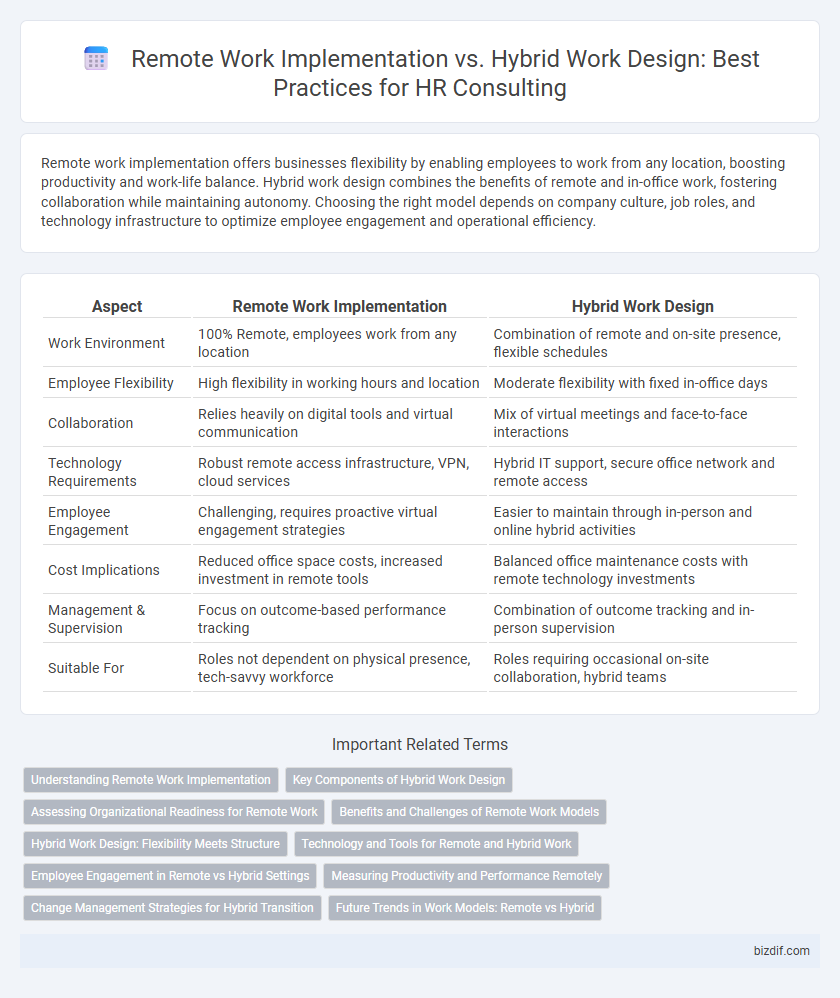Remote work implementation offers businesses flexibility by enabling employees to work from any location, boosting productivity and work-life balance. Hybrid work design combines the benefits of remote and in-office work, fostering collaboration while maintaining autonomy. Choosing the right model depends on company culture, job roles, and technology infrastructure to optimize employee engagement and operational efficiency.
Table of Comparison
| Aspect | Remote Work Implementation | Hybrid Work Design |
|---|---|---|
| Work Environment | 100% Remote, employees work from any location | Combination of remote and on-site presence, flexible schedules |
| Employee Flexibility | High flexibility in working hours and location | Moderate flexibility with fixed in-office days |
| Collaboration | Relies heavily on digital tools and virtual communication | Mix of virtual meetings and face-to-face interactions |
| Technology Requirements | Robust remote access infrastructure, VPN, cloud services | Hybrid IT support, secure office network and remote access |
| Employee Engagement | Challenging, requires proactive virtual engagement strategies | Easier to maintain through in-person and online hybrid activities |
| Cost Implications | Reduced office space costs, increased investment in remote tools | Balanced office maintenance costs with remote technology investments |
| Management & Supervision | Focus on outcome-based performance tracking | Combination of outcome tracking and in-person supervision |
| Suitable For | Roles not dependent on physical presence, tech-savvy workforce | Roles requiring occasional on-site collaboration, hybrid teams |
Understanding Remote Work Implementation
Remote work implementation involves establishing infrastructure, communication protocols, and policies that enable employees to perform tasks efficiently outside a traditional office setting. Key elements include secure technology platforms, clear performance metrics, and consistent remote collaboration tools to maintain productivity and engagement. Understanding these components enhances organizational agility and supports seamless workforce transitions to fully remote environments.
Key Components of Hybrid Work Design
Hybrid work design integrates the flexibility of remote work with on-site collaboration, emphasizing key components such as technology infrastructure, employee experience, and clear communication protocols. Effective hybrid models require secure digital tools for seamless connectivity, designated spaces for in-person teamwork, and policies that balance autonomy with accountability. Prioritizing employee well-being and inclusive culture supports productivity and retention in hybrid work environments.
Assessing Organizational Readiness for Remote Work
Assessing organizational readiness for remote work involves evaluating technological infrastructure, employee digital literacy, and management capabilities to support virtual collaboration. Key metrics include bandwidth capacity, cybersecurity protocols, and remote work policy clarity to ensure seamless communication and data protection. Understanding employee preferences and job roles helps tailor remote or hybrid designs, optimizing productivity and engagement across diverse work settings.
Benefits and Challenges of Remote Work Models
Remote work implementation offers benefits including increased employee autonomy, reduced commute times, and cost savings on office space, enhancing overall job satisfaction and productivity. Challenges include communication barriers, potential feelings of isolation, and difficulties in maintaining team cohesion and company culture. Balancing technology tools and clear remote work policies is essential to overcome these obstacles and maximize the effectiveness of remote work models.
Hybrid Work Design: Flexibility Meets Structure
Hybrid work design balances flexibility and structure by integrating remote and on-site work schedules tailored to employee roles. Implementing hybrid models increases productivity and employee satisfaction by fostering collaboration while accommodating individual work preferences. HR consulting ensures seamless hybrid transitions through strategic policy development, technology adoption, and continuous performance monitoring.
Technology and Tools for Remote and Hybrid Work
Effective HR consulting emphasizes choosing technology and tools tailored to remote work implementation and hybrid work design to enhance productivity and collaboration. Remote work relies heavily on cloud-based platforms like Microsoft Teams, Zoom, and Slack for seamless communication and project management tools such as Asana and Trello to track tasks across distributed teams. Hybrid work design integrates these technologies with smart office solutions and scheduling apps like Robin or Envoy to optimize in-office resource utilization and maintain flexible employee engagement.
Employee Engagement in Remote vs Hybrid Settings
Remote work implementation enhances employee engagement by offering flexibility and autonomy, which boosts job satisfaction and productivity. Hybrid work design combines the benefits of remote and in-office interactions, fostering collaboration and maintaining social connections vital for team cohesion. Optimizing engagement strategies in both settings requires tailored communication tools and regular feedback mechanisms that address unique employee needs and preferences.
Measuring Productivity and Performance Remotely
Measuring productivity and performance remotely requires leveraging data-driven tools such as time-tracking software, project management platforms, and regular performance analytics to ensure accountability and transparency. Hybrid work design demands customized evaluation metrics that balance in-office collaboration efficiency with remote output quality, using key performance indicators (KPIs) tailored for varied work environments. HR consulting emphasizes continuous feedback loops, employee engagement surveys, and outcome-based assessments to optimize productivity regardless of work location.
Change Management Strategies for Hybrid Transition
Effective change management strategies for hybrid transition prioritize clear communication channels and employee engagement to address the complexities of balancing in-office and remote work. Utilizing data-driven insights to tailor training programs and support systems ensures adaptability and reduces resistance during the shift from remote work implementation to hybrid work design. Continuous feedback loops enable HR consultants to refine policies, fostering a cohesive, productive hybrid workforce aligned with organizational objectives.
Future Trends in Work Models: Remote vs Hybrid
Future trends in work models indicate a growing preference for hybrid work design, combining remote flexibility with in-office collaboration to enhance employee productivity and engagement. HR consulting increasingly emphasizes data-driven strategies to tailor work environments that align with organizational goals and workforce preferences. Remote work implementation continues to evolve with advanced digital tools, but hybrid models are projected to dominate as companies seek balance between autonomy and team synergy.
Remote Work Implementation vs Hybrid Work Design Infographic

 bizdif.com
bizdif.com